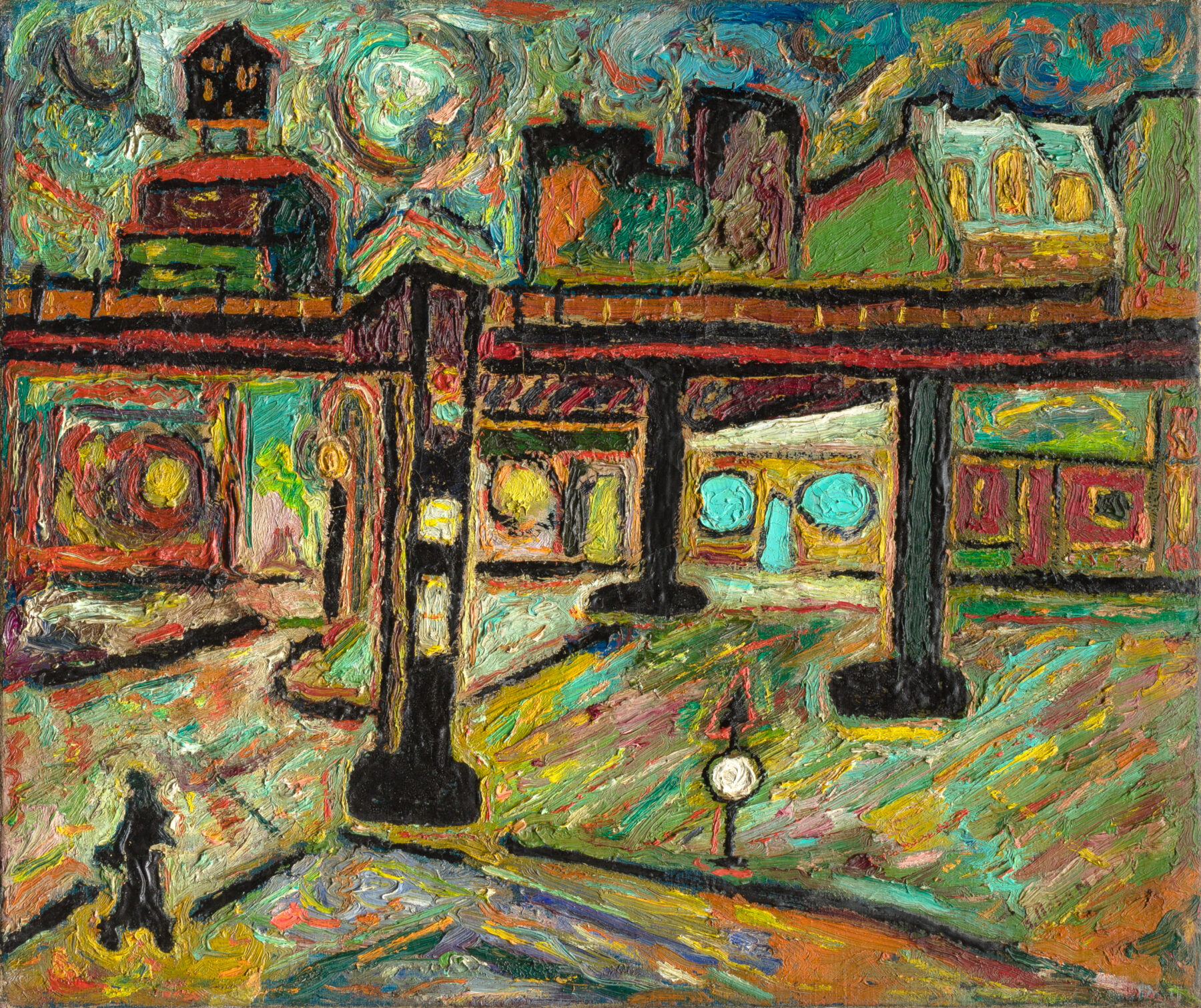Beauford Delaney
Beauford Delaney is one of the most important figures in American modernism, with his colorful works that range from figurative expressionism to abstraction. Born in Knoxville, Tennessee in 1901, he was raised in a strict Christian household. Despite his conservative upbringing, Delaney’s mother recognized her son’s artistic abilities and provided a supportive environment for his growth. In 1923, Delaney left the South for Boston, where he would study art over the next six years at the Massachusetts Normal School (later the Massachusetts College of Art), the Copley Society, the Lowell Institute, and the South Boston School of Art. Delaney moved to New York in 1929 and first settled in Harlem. He established a reputation in his early career painting portraits of society women and professional dancers. Delaney featured these portraits at his first solo exhibition at the 135th Street Branch Library of the New York Public Library in 1930. In the same year, three of his portraits were exhibited at the Whitney Studio Galleries, the predecessor of the Whitney Museum of American Art. While he built his early career, Delaney also studied at the Art Students League, working with John Sloan and Thomas Hart Benton.
As the Depression wore on, Delaney also found work with the Federal Art Project as a muralist. Delaney collaborated with Charles Alston on two murals at the Harlem Hospital Center. Alston was a key figure in the Harlem Renaissance, and he brought Delaney into an influential group of artists that included Norman Lewis, Jacob Lawrence, Augusta Savage, and Romare Bearden among others. These figures, along with Delaney, frequently worked and socialized together at Alston’s studio in Harlem known as “306.” Delaney was also equally comfortable in the bohemian circles of Greenwich Village, where he lived and worked from 1936 to 1953 at 181 Greene Street.
The years in Greenwich Village were marked with great productivity and a new energetic, modern style. Delaney was interested in the development of modernism in Europe and the United States, and began to study and engage with the artists he admired. Alfred Stieglitz and Stuart Davis were influential mentors; Delaney regularly visited Stieglitz’s An American Place gallery, and Davis encouraged him to study the European masters— Cézanne, Gauguin, Matisse, Picasso, and Van Gogh. By 1939, Beauford’s paintings reflected these lessons and he exhibited his new works at several solo shows in New York and Washington D.C.
The paintings he created between 1936 and 1953 are known as the Greene Street paintings, and they include portraits, still lifes, street scenes, and modernist interiors. The cityscapes were especially reflective of Delaney’s unique concept of modernism. Inspired by the surrounding parks and streets close to his studio, Delaney painted everyday life seen on the streets. While the Greene Street paintings depict various locations, they are unified by the thick, impasto paint, the dynamic use of line, and the expressive Fauvist-inspired color palette. The cityscapes share a few signature motifs, such as fire hydrants, lampposts, directional signs, fire escapes, and manhole covers. These recognizable elements are interspersed with geometric lines and forms, rendering the paintings a combination of abstraction and figuration.
The present work is a rare and exceptional example of Delaney’s Greene Street paintings. The untitled work, painted ca. 1945-46, is a nocturnal scene depicting a street corner and the El train, which intersects the foreground of the composition. Underneath the tracks is a lone, dark figure walking below, dwarfed by the enormity of the city. A dense group of buildings rise above the train tracks, with the familiar silhouette of a water tower at left. Delaney painted the clouds and sky with quick, swirling brushstrokes in a palette of exuberant jewel tones reminiscent of Van Gogh. Thick impasto applications of paint are used throughout the composition, creating patterns and textural shapes that illuminate his painting technique. Despite the otherwise ordinary subject, Delaney transformed the painting into a lyrical expression of color and movement.
Untitled (Greenwich Village Street), was previously in the collection of Kenneth Lash (1918-1985), a professor based in California and Iowa. Lash was a poet, essayist, university professor, and chair of art and humanities departments. He was a contributor to many literary reviews and journals, including The New Yorker, editor of the New Mexico Quarterly and a longtime contributing editor at the North American Review. Lash would have met Delaney when he lived in New York in the early 1940s. Like Delaney, he was known to frequent jazz clubs in Greenwich Village, and after-hours sessions at trumpeter Frankie Newton’s loft, which was nearby Delaney’s studio. Lash was among the many friends and patrons who provided financial support to Delaney when he was in distress.
In 1953, Delaney left New York and permanently settled in Paris. Delaney followed the path of his friend James Baldwin, but also joined a number of African American artists who relocated to Europe seeking respite from the racial inequalities of the United States. In Paris, Delaney felt more free to express himself and his style shifted towards Abstract Expressionism. The vibrant compositions he painted in Europe are made up of thick layers of impasto paint, applied with energetic brushstrokes. His use of exuberant monochromatic shades reflects Monet’s studies of light, and symbolize transcendence and spirituality. Despite health and financial woes, Delaney continued to live and work in Paris until his death in 1979.
The small group of known Greene Street paintings are primarily in important private collections, and select museums, including the Virginia Museum of Fine Arts; the Portland Art Museum, Portland, Oregon; the Museum of Fine Arts, Boston, Massachusetts; and the Rose Art Museum, Brandeis University, Waltham, Massachusetts. The present work has been in the Lash family collection for nearly sixty years, underscoring its significance and rarity among the group of Greene Street paintings.
Beauford Delaney is one of the most important figures in American modernism, with his colorful works that range from figurative expressionism to abstraction. Born in Knoxville, Tennessee in 1901, he was raised in a strict Christian household. Despite his conservative upbringing, Delaney’s mother recognized her son’s artistic abilities and provided a supportive environment for his growth. In 1923, Delaney left the South for Boston, where he would study art over the next six years at the Massachusetts Normal School (later the Massachusetts College of Art), the Copley Society, the Lowell Institute, and the South Boston School of Art. Delaney moved to New York in 1929 and first settled in Harlem. He established a reputation in his early career painting portraits of society women and professional dancers. Delaney featured these portraits at his first solo exhibition at the 135th Street Branch Library of the New York Public Library in 1930. In the same year, three of his portraits were exhibited at the Whitney Studio Galleries, the predecessor of the Whitney Museum of American Art. While he built his early career, Delaney also studied at the Art Students League, working with John Sloan and Thomas Hart Benton.
As the Depression wore on, Delaney also found work with the Federal Art Project as a muralist. Delaney collaborated with Charles Alston on two murals at the Harlem Hospital Center. Alston was a key figure in the Harlem Renaissance, and he brought Delaney into an influential group of artists that included Norman Lewis, Jacob Lawrence, Augusta Savage, and Romare Bearden among others. These figures, along with Delaney, frequently worked and socialized together at Alston’s studio in Harlem known as “306.” Delaney was also equally comfortable in the bohemian circles of Greenwich Village, where he lived and worked from 1936 to 1953 at 181 Greene Street.
The years in Greenwich Village were marked with great productivity and a new energetic, modern style. Delaney was interested in the development of modernism in Europe and the United States, and began to study and engage with the artists he admired. Alfred Stieglitz and Stuart Davis were influential mentors; Delaney regularly visited Stieglitz’s An American Place gallery, and Davis encouraged him to study the European masters— Cézanne, Gauguin, Matisse, Picasso, and Van Gogh. By 1939, Beauford’s paintings reflected these lessons and he exhibited his new works at several solo shows in New York and Washington D.C.
The paintings he created between 1936 and 1953 are known as the Greene Street paintings, and they include portraits, still lifes, street scenes, and modernist interiors. The cityscapes were especially reflective of Delaney’s unique concept of modernism. Inspired by the surrounding parks and streets close to his studio, Delaney painted everyday life seen on the streets. While the Greene Street paintings depict various locations, they are unified by the thick, impasto paint, the dynamic use of line, and the expressive Fauvist-inspired color palette. The cityscapes share a few signature motifs, such as fire hydrants, lampposts, directional signs, fire escapes, and manhole covers. These recognizable elements are interspersed with geometric lines and forms, rendering the paintings a combination of abstraction and figuration.
The present work is a rare and exceptional example of Delaney’s Greene Street paintings. The untitled work, painted ca. 1945-46, is a nocturnal scene depicting a street corner and the El train, which intersects the foreground of the composition. Underneath the tracks is a lone, dark figure walking below, dwarfed by the enormity of the city. A dense group of buildings rise above the train tracks, with the familiar silhouette of a water tower at left. Delaney painted the clouds and sky with quick, swirling brushstrokes in a palette of exuberant jewel tones reminiscent of Van Gogh. Thick impasto applications of paint are used throughout the composition, creating patterns and textural shapes that illuminate his painting technique. Despite the otherwise ordinary subject, Delaney transformed the painting into a lyrical expression of color and movement.
Untitled (Greenwich Village Street), was previously in the collection of Kenneth Lash (1918-1985), a professor based in California and Iowa. Lash was a poet, essayist, university professor, and chair of art and humanities departments. He was a contributor to many literary reviews and journals, including The New Yorker, editor of the New Mexico Quarterly and a longtime contributing editor at the North American Review. Lash would have met Delaney when he lived in New York in the early 1940s. Like Delaney, he was known to frequent jazz clubs in Greenwich Village, and after-hours sessions at trumpeter Frankie Newton’s loft, which was nearby Delaney’s studio. Lash was among the many friends and patrons who provided financial support to Delaney when he was in distress.
In 1953, Delaney left New York and permanently settled in Paris. Delaney followed the path of his friend James Baldwin, but also joined a number of African American artists who relocated to Europe seeking respite from the racial inequalities of the United States. In Paris, Delaney felt more free to express himself and his style shifted towards Abstract Expressionism. The vibrant compositions he painted in Europe are made up of thick layers of impasto paint, applied with energetic brushstrokes. His use of exuberant monochromatic shades reflects Monet’s studies of light, and symbolize transcendence and spirituality. Despite health and financial woes, Delaney continued to live and work in Paris until his death in 1979.
The small group of known Greene Street paintings are primarily in important private collections, and select museums, including the Virginia Museum of Fine Arts; the Portland Art Museum, Portland, Oregon; the Museum of Fine Arts, Boston, Massachusetts; and the Rose Art Museum, Brandeis University, Waltham, Massachusetts. The present work has been in the Lash family collection for nearly sixty years, underscoring its significance and rarity among the group of Greene Street paintings.
Beauford Delaney
Untitled (Greenwich Village Street, New York), c. 1945-46
Oil on canvas
18″ x 21 1/2″
Signed and dated lower right Signed and inscribed on the verso
Provenance
Professor Kenneth Lash, California and Iowa, acquired directly from the artist
Private Collection, Washington, acquired by descent from the above, 2006
Sold, Swann Auction Galleries, October 3, 2024, lot 16

